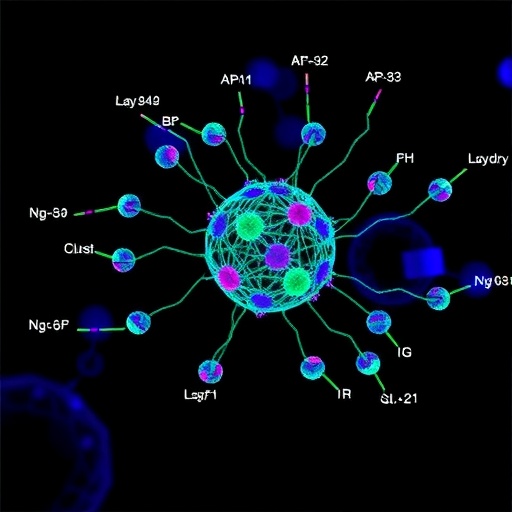In a breakthrough that could redefine our understanding of cellular control mechanisms, researchers have unveiled a novel system that precisely manipulates the phosphorylation state of p53—a pivotal tumor suppressor protein—through the innovative deployment of nanobody-coupled kinases. This pioneering approach, recently detailed by Lim and Yoo in Cell Death Discovery, promises to unlock unprecedented control over cellular fate, potentially transforming therapeutic strategies for cancer and other diseases where p53 plays a central role.
The tumor suppressor p53 is often hailed as the “guardian of the genome” due to its critical function in safeguarding cells from malignant transformation. Its activity is stringently modulated by various post-translational modifications, among which phosphorylation is key. Phosphorylation events dictate p53’s stability, interactions, and transcriptional programs, orchestrating a fine-tuned balance between cellular proliferation, arrest, DNA repair, and apoptosis. However, traditional methods to alter p53 phosphorylation are typically broad-spectrum and lack temporal and spatial precision, limiting their therapeutic utility.
Addressing this long-standing challenge, Lim and Yoo’s team engineered a cutting-edge nanobody-coupled kinase system that targets p53 with extraordinary specificity. Nanobodies—single-domain antibody fragments derived from camelid antibodies—possess remarkable stability and can be tailored to recognize unique protein epitopes. By fusing these nanobodies directly to kinases, the researchers created a molecular device capable of delivering phosphorylation modifications to discrete sites on p53, effectively “rewriting” cellular states on demand.
This technology leverages the modularity of nanobodies to target distinct forms or conformations of p53, allowing targeted phosphorylation that impacts protein function in a highly controlled manner. Unlike conventional kinase treatments, which might phosphorylate off-target proteins and induce unintended consequences, this system confines kinase activity precisely where it is needed, circumventing off-target effects and enhancing therapeutic indices.
The experimental validation involved engineering nanobody-kinase fusions specific to phosphorylation sites of p53 critical for its activation and stabilization. Cellular assays demonstrated that the application of these fusion proteins could reliably alter p53 phosphorylation status, triggering downstream signaling cascades that led to expected phenotypic outcomes such as cell cycle arrest or apoptosis, contingent on the phosphorylation landscape imposed.
One of the most striking implications of this work is the ability to reversibly toggle cellular fate decisions by dynamically modulating p53 states. For example, in tumor-derived cells with dysfunctional p53 pathways, re-establishing controlled phosphorylation could restore tumor suppressor functions, inhibiting unchecked proliferation. Importantly, the nanobody-coupled kinase system manifests a high degree of tunability, allowing for temporal control that mimics physiological signaling patterns rather than static modifications.
Moreover, this technique holds promise beyond cancer biology. Given p53’s involvement in metabolism, senescence, and immune responses, the capacity to direct site-specific phosphorylation could lead to breakthroughs in understanding aging processes, metabolic disorders, and immune system dysregulation. The modular design of the nanobody-kinase constructs arguably paves the way for analogous systems targeting other critical regulatory proteins implicated in various disease contexts.
The investigators also addressed potential challenges regarding delivery and intracellular targeting of the nanobody-kinase complexes. Utilizing advanced vector systems and protein transduction domains, the team ensured efficient cellular uptake and nuclear localization to engage p53 within its native environment. This meticulous design underscores the comprehensive strategy required to translate molecular tools into functional therapeutic agents.
Mechanistically, the selective phosphorylation delivered by the nanobody-coupled kinases modulates key structural elements of p53 that govern its DNA-binding affinity and interactions with co-regulators. By altering these dynamics, the system can shift the balance of p53 activity towards different gene expression programs—a level of precision that could harness p53’s pleiotropic roles without triggering deleterious side effects.
In addition to functional outcomes, the method offers an investigative platform to dissect p53 biology at an unprecedented resolution. By engineering nanobody-kinases targeting different phosphorylation sites independently or in combination, researchers can map the complex “phosphocode” governing p53 activity and decode how multilayered phosphorylation patterns dictate responses to stress and damage signals.
From a clinical perspective, the nanobody-coupled kinase technology could serve as a prototype for targeted protein modulation therapies. Unlike gene editing or RNA interference, which globally alter protein expression, this system provides a rapid, reversible, and site-specific modification strategy that might better accommodate the dynamic nature of protein regulation in cells.
While the current study primarily focuses on proof-of-concept and foundational insights, future work is anticipated to explore in vivo applications, delivery optimization, and the development of synthetic biology circuits integrating this phosphorylation control system. Such advances could herald an era where we command cellular states at will, offering personalized approaches to counteract diseases driven by dysregulated protein function.
Experts in the field are already lauding this study as a significant leap forward in molecular cell biology and synthetic biology. The convergence of nanobody technology with kinase enzymology exemplifies the innovative spirit needed to engineer next-generation cellular control modalities. This work not only opens new therapeutic avenues but also reshapes the fundamental toolkit available to interrogate protein function with exquisite precision.
Given the centrality of p53 in cancer and other pivotal biological processes, the capacity to harness site-specific phosphorylation through nanobody-guided kinase activity offers a versatile platform with transformative potential. This research exemplifies how integrating molecular engineering with cellular biology can lead to groundbreaking solutions long sought by the biomedical community.
As the world watches closely, this pioneering nanobody-coupled kinase system’s broader implications might stretch far beyond p53, paving the way for similarly precise interventions that modulate other critical proteins implicated in human health and disease. The era of tailored post-translational modification therapy could well be emerging, promising new horizons in biomedicine.
The study by Lim and Yoo thus represents a monumental stride in the quest to control cellular behavior at an atomic level. Their innovative fusion of nanobody targeting with kinase enzymatic power exemplifies the frontiers of molecular engineering, offering hopes of refashioning cellular destiny in ways previously thought impossible.
Article Title:
Regulation of cellular states via targeted phosphorylation of p53 using a nanobody-coupled kinase system
Article References:
Lim, H.E., Yoo, H.Y. Regulation of cellular states via targeted phosphorylation of p53 using a nanobody-coupled kinase system. Cell Death Discov. 11, 527 (2025). https://doi.org/10.1038/s41420-025-02821-1




